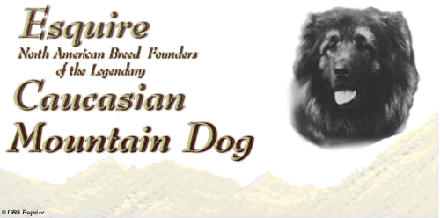

|
|
|

|
|
|
"Shepherding" and "Sentinel" Dogs Distinguished
by Stacey Kubyn Within the lumped Caucasian breed are 3 subtypes historically utilized for different purposes - herding dogs, guarding dogs and fighting dogs. Marina Kuznetsova writes on this point, excerpted below. Compare that to the excerpt (also below) from On Dogs In Tibet by Don Messerschmidt, distinguishing "livestock protection dogs" from "guard dogs" in Tibet. The Caucasian is thought to be closely related to the Tibetan dogs. Different historical purposes can account for temperament differences in modern Caucasian lines. Modern breed standards describe Caucasian temperament as "well developed defensive reactions, professed in the active form (ADR)" without specifying the stimuli---human or predator---a flawed omission that ignores the historical development of the breed. When talking in terms of character, temperament and inherent breed defense reaction, be sure to factor in the historical differences of dogs geared toward predator control (ie "shepherding type") and those historical used as sentinel guardians. A dog that is gentle with people may have a high active defense reaction (ADR) if functioning as a livestock guardian against predators. From "The Caucasian Ovcharka (Mountain Dog)" by Marina Kuznetsova : "Their dogs are kept outside and can be differentiated into three groups used for different purposes- herding dogs, guarding dogs and fighting dogs. The herding dogs must be steady, hardy, not spiteful to people and domestic animals but with the ability hurry up the lone sheep with a nip at the hinds legs. These dogs must protect the flock against wolves. ..." "Guarding dogs who protect the house differ from the herding dogs because of their extreme aggressiveness towards strangers, but as a rule they respect and listen to their owner. Although the dogs are not aggressive towards the people who live in the house they obey only one master. These dogs do not bark alot and will attack strangers who enter the protected area. However, outside the protected area the dogs can be walked off leash and are usually not aggressive with non-threatening strangers." From the ATMA Gazette Sept 1986, "On Dogs In Tibet" by Don Messerschmidt "I had tea last week with my Tibetan friend, Karma Wangyel and his family, when the topic of Tibetan dogs come up. They remember vividly by big dog"KALU" (Saipal Baron), and know that I am collecting legends and lore about these giant dogs. Here is some of what I learned from them. Tibetans distinguish seven kinds of dogs in their homeland. Six are "purebred", or relatively so: the seventh is a mongrel cross-breed of ill-repute : 1) KHYI ("dog") or Tibetan Mastiff (as we know it), the well known livestock protection dog kept by the Drog-pa nomadic herders of western Tibet and shepherds of the Himalayan regions. This dog is renowned as a fighter, controlling wolves and other predators. It makes its rounds of the Yak or sheep herds during the night, and has a good, deep bark. It has a sharp scenting ability known as zi nobo in Tibetan, and is a good tracker. It is also accustomed to cold and windy weather. Its hair is not exceedingly long: it has a good solid head and body, with a bushy tail over the back. In short, all that we consider a prime Tibetan Mastiff to be. The "best colors", my friends say, are black and tawny dog with two "eye spots", or an all black dog with a white star on the chest. 2) SANG KHYI ("best dog"), sometimes referred to as DO-KHYI ("tied"). Compared with the ordinary KHYI, above (Tibetan Mastiff), the SANG KHYI in its prime is a rare dog. In fact, my friends described my dog"KALU" as a cross between KHYI and SANG KHYI. The SANG KHYI is primarily a guard dog, typically tied at the gate of monasteries and farm compounds. It has, according to a Tibetan saying. "Big head,big ears, big mouth (jowls), and big back", but my friends were quick to point out that it is not a good running dog and has a generally narrow and poorly structured rear end. The SANG KHYI is known for his ferocity as a barker, especially at night. He's not an especially good runner, tracker or fighter, and because he does't have a very good quality fur, he can't stand the cold as much as a true Tibetan Mastiff." (c)1997 Stacey Kubyn |
|

|